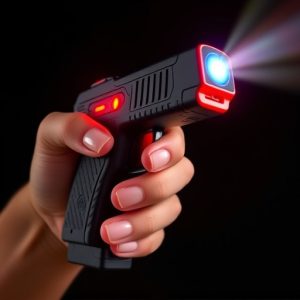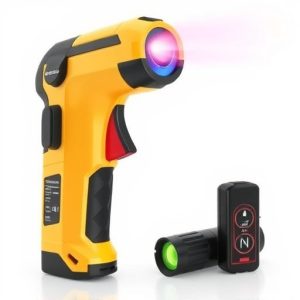Stun Gun Safety and Efficacy: A Focus on Alarm and Strobe Light Features
Stun guns have evolved into more sophisticated personal defense tools, featuring alarm and light sy…….
Stun guns have evolved into more sophisticated personal defense tools, featuring alarm and light systems that significantly enhance their capabilities. Modern stun guns combine a high-voltage shock to incapacitate attackers with an integrated loud alarm and bright strobe light, acting as potent deterrents by drawing attention and disorienting potential assailants. The alarm can alert others and potentially lead to the identification of the attacker, while the strobe light can impair the aggressor's vision and coordination. These features are particularly beneficial in low-light conditions, aiding in the precise use of the stun gun. While these devices offer a non-lethal means of self-defense, their effectiveness relies on user proficiency and an understanding of situational contexts. It is crucial to undergo proper training and comply with legal guidelines when using stun guns with alarm and lights systems to ensure safe and effective deployment in protective situations.
When it comes to personal safety devices, stun guns have long been a viable option for deterring threats. The integration of alarm and strobe light features has further enhanced their effectiveness, turning them into multifunctional deterrents that can disorient assailants while alerting others. This article delves into the capabilities and functionality of these advanced stun guns with alarm and lights, exploring their mechanics, efficacy, and safety considerations. Join us as we navigate through ‘stun guns with alarm and lights’, a critical examination of how these devices serve as more than just a physical barrier against harm.
Understanding Stun Guns with Alarm and Light Features
Stun guns have evolved over the years, incorporating additional safety features to enhance their effectiveness and deterrence capabilities. Among these advancements are models equipped with alarm and light systems. These stun guns serve as a multifaceted self-defense tool by emitting a high-voltage electric charge capable of incapacitating an attacker, coupled with a loud audible alarm and a bright strobe light. The integration of an alarm is particularly beneficial as it can deter assailants by drawing attention to the incident and signaling for help. This feature acts as a psychological barrier, often causing potential aggressors to reconsider their actions due to the risk of exposure.
The inclusion of a strobe light in stun guns with alarm and lights is another critical feature. The pulsating beam can disorient an attacker, further impairing their vision and coordination. This visual disruption buys valuable time for individuals to escape or for bystanders to intervene. Additionally, the light system can aid users in aiming the device more effectively during low-light conditions, ensuring that the stun gun’s electric charge is delivered precisely where needed. Users of these advanced stun guns should familiarize themselves with the operation of both the alarm and light systems to maximize their self-defense potential in various situations. Understanding how to deploy these features under pressure can be a critical aspect of personal safety strategies.
The Mechanism Behind Stun Guns with Integrated Alarms and Illumination
Stun guns have evolved over time, integrating advanced features to enhance personal security beyond their primary incapacitating function. Among these innovations are models equipped with alarm and illumination systems. These stun guns with alarm and lights serve a dual purpose: to deter potential attackers and to improve the user’s situational awareness. The mechanism behind these devices is multifaceted, incorporating electronic components that activate both the alarm and the bright light upon activation.
When deployed, the stun gun emits an intense electrical charge capable of incapacitating an assailant by disrupting muscle function, causing a loss of balance or immobility. This effect is achieved through the delivery of a high-voltage, low-current shock that targets the motor neurons. Simultaneously, the integrated alarm—a loud siren—serves to attract attention and scare off aggressors. The illumination feature, typically a strobe light, adds another layer of defense by temporarily blinding an adversary or providing visibility in low-light conditions. This combination of physical disorientation, auditory distraction, and visual impairment makes stun guns with alarm and lights highly effective self-defense tools for a wide range of users seeking to protect themselves in potentially dangerous situations.
Evaluating the Efficacy and Safety of Stun Guns with Alarm and Strobe Light Capabilities
Stun guns equipped with alarm and strobe light features have garnered attention as personal security devices that offer a multifaceted approach to self-defense. The efficacy of these devices is rooted in their ability to incapacitate an assailant through the delivery of an electric shock, which can be disorienting and immobilizing. The shock provided by stun guns is typically non-lethal, designed to deliver a powerful electrical stimulus that interferes with muscle control and causes pain, potentially deterring attackers without causing permanent injury.
In addition to the electric shock, stun guns with integrated alarms serve as a deterrent and an alert mechanism. The loud audible sound can attract attention, disrupting the attacker’s focus and drawing the notice of nearby individuals. This feature can be particularly valuable in public spaces where there are chances of bystanders intervening upon hearing the alarm. The strobe light functionality further enhances the device’s visibility during confrontations, which can improve accuracy for both the user and potential witnesses. However, it is crucial to consider the context in which these stun guns are used; their effectiveness may vary depending on factors such as environmental conditions, the perpetrator’s level of intoxication or aggression, and the individual’s training with the device. Safety measures must be taken to ensure that the device is only used in situations where personal harm is imminent, as the misuse can lead to unfortunate outcomes. Training and adherence to local laws are paramount for users to employ stun guns with alarm and lights effectively and safely.


